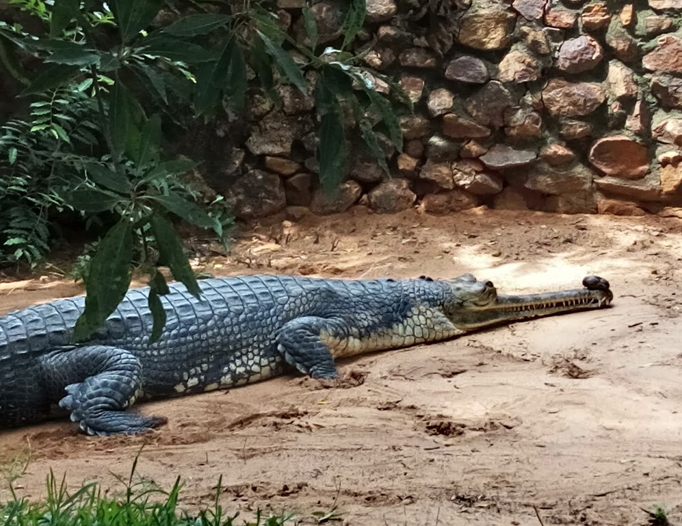Total Weight
Height
Diet
Lifespan
Total Weight
Height
Diet
Lifespan
The Gharial, is a critically endangered crocodilian species found in the rivers of the Indian subcontinent. It has a distinct long, narrow snout with sharp teeth. The Gharial is specialized for a piscivorus diet, primarily feeding on fish. Males can reach lengths of up to 6 meters,
while females are slightly smaller. This species is well-adapted to aquatic life, with webbed feet and a long, powerful tail for swimming.
Patna zoo is famous for crocodile breeding. Crocodiles is a successful example of ex-situ and in-situ conservation. e conservation breeding of crocodile in Patna zoo
is very much appreciable and it recently has successfully released gharial into Gandak river.


The gharial is known for its unique bulbous growth on the snout called a "ghara" in males, which produces a resonating sound during courtship. Habitat loss, river pollution, and
hunting have led to its decline, making conservation efforts crucial for its survival.
Patna zoo features a dedicated state of the art enclosure for the conservation of the critically endangered gharial, a unique crocodilian species enclosure provides a suitable habitat for the gharial, which are known for their long, narrow snouts and distinct, fish-like bodies. e gharial in Patna zoo are part of conservation efforts aimed at preserving this species and it has shown incredibly successful results.
Visitors can observe and learn about the gharial's natural behaviour, unique adaptations, and the challenges they face in the wild.
The alligator is a fascinating reptile known for its powerful build, sharp teeth, and incredible swimming abilities.
At Patna Zoo, visitors can observe these ancient creatures in a specially designed habitat that mimics their natural environment.
| Attribute | Details |
|---|---|
| Weight | Males: Around 360-450 kg, Females: Around 200-230 kg |
| Length | Typically 10-15 feet (males), 8-10 feet (females) |
| Diet | Fish, birds, mammals, amphibians, reptiles, and carrion |
| Lifespan | 35-50 years in the wild, longer in captivity |
| Conservation Status | Least Concern (American Alligator), some related species are more threatened |
| Population in the Wild | Stable population across southeastern United Statesa |
| Social Structure | Generally solitary but tolerate others in prime basking or feeding areas |
| Unique Behavior | Powerful swimmers using tails, can stay submerged for long periods |
| Feeding Pattern | Carnivores — opportunistic hunters, ambush prey in or near water |
| Skin Feature | Thick, armored skin with tough scales (scutes) for protection |
| Closest Relatives | Closely related to crocodiles, caimans, and gharials — all part of the Crocodylia order |
Alligators are carnivores, meaning they primarily eat meat. Their diet consists of a wide variety of animals including fish, birds, turtles, amphibians, and small to medium-sized mammals. Young alligators often feed on insects, small fish, and amphibians, while adults hunt larger prey such as deer, raccoons, or even other alligators.
Alligators are ambush predators — they lie in wait near the water's edge, staying almost completely submerged, and strike quickly when prey comes near. They are also opportunistic feeders, eating whatever they can catch, including carrion (dead animals) when available.
Their strong jaws and sharp teeth allow them to crush shells and bones with ease. While they prefer fresh prey, alligators are adaptable and will scavenge if necessary.
Open Now
All visits to Patna Zoo help fund our work both at the zoo and worldwide.